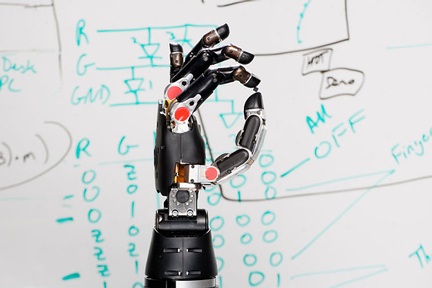Robotic arm enables paralysed man to 'feel' again
A prosthetic arm has been directly connected to the brain of a paralysed man, enabling him to ‘feel’ physical sensations and even identify which mechanical finger is being gently touched.

The 28-year-old has been paralysed for more than a decade as a result of a spinal cord injury.
The research heralds a future in which people living with paralysed or missing limbs will not only be able to manipulate objects by sending signals from their brain to robotic devices, but also be able to sense precisely what those devices are touching.
The hand, developed by the Applied Physics Laboratory at Johns Hopkins University, is part of a research project into advanced replacement limbs funded by the US military’s Defense Advanced Research Projects Agency (DARPA).
“We’ve completed the circuit,” said DARPA program manager Justin Sanchez.
“Prosthetic limbs that can be controlled by thoughts are showing great promise, but without feedback from signals traveling back to the brain it can be difficult to achieve the level of control needed to perform precise movements. By wiring a sense of touch from a mechanical hand directly into the brain, this work shows the potential for seamless bio-technological restoration of near-natural function.”
The clinical work involved placing electrode arrays onto the paralysed man’s sensory cortex — the brain region responsible for identifying tactile sensations such as pressure. In addition, the team placed arrays on his motor cortex, the part of the brain that directs body movements.
Wires were run from the electrode arrays on the motor cortex to a mechanical hand developed by the Applied Physics Laboratory (APL) at Johns Hopkins University. That gave the man the ability to control the hand’s movements with his thoughts.
Then, breaking new neurotechnological ground, the researchers went on to provide the man with a sense of touch. The hand contains sophisticated torque sensors that can detect when pressure is being applied to any of its fingers, and can convert physical ‘sensations’ into electrical signals.
In the very first set of tests, in which researchers gently touched each of the prosthetic hand’s fingers while he was blindfolded, he was able to report with nearly 100 per cent accuracy which mechanical finger was being touched. The feeling, he reported, was as if his own hand were being touched.
“At one point, instead of pressing one finger, the team decided to press two without telling him,” said Mr Sanchez, who oversees the Revolutionizing Prosthetics program. “He responded in jest asking whether somebody was trying to play a trick on him. That is when we knew that the feelings he was perceiving through the robotic hand were near-natural.”
DARPA has been working to restore movement to quadriplegics, amputees and others in need of a functional limb – such as soldiers injured while on duty.
Latest News
 29-Jul-24
Dementia Bus gives carehome.co.uk staff insight into life with dementia
29-Jul-24
Dementia Bus gives carehome.co.uk staff insight into life with dementia
 01-Mar-24
Find out the top care homes in 2024
01-Mar-24
Find out the top care homes in 2024
 21-Mar-23
UK's top care homes in 2023 revealed
21-Mar-23
UK's top care homes in 2023 revealed
 03-Jan-23
carehome.co.uk launches free care helpline
03-Jan-23
carehome.co.uk launches free care helpline
 13-Dec-22
5 mins with Emily Whitehurst, chief operating officer for Constantia Healthcare
13-Dec-22
5 mins with Emily Whitehurst, chief operating officer for Constantia Healthcare